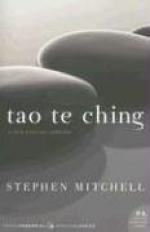|
This section contains 469 words (approx. 2 pages at 400 words per page) |

|
Tao Te Ching Summary & Study Guide Description
Tao Te Ching Summary & Study Guide includes comprehensive information and analysis to help you understand the book. This study guide contains the following sections:
This detailed literature summary also contains Topics for Discussion on Tao Te Ching by Stephen Mitchell.
The TAO TE CHING by Lao-tzu is a classic work of Chinese philosophy that talks about the art of living, embracing an inscrutable, eternal Way (Tao). Stephen Mitchell presents it in a free translation, with endnotes that offer literal translations in some cases, short commentaries, and examples.
TAO TE CHING (pronounced roughly: Dow Deh Jing) is a classical work of Chinese philosophy dating from the time of Confucius (551-479 BCE), authored by Lao-tzu, whose name means "The Old Master" or "The Old Boy." It talks about the art of living with humor, grace, large-heartedness, and deep wisdom. Translator Stephen Mitchell aims to provide in English the effect that Lao-tzu would have had on an ancient Chinese reader. Whenever he feels his "improvisations" are too radical, he provides the literal text in endnotes.
From the outset, the book differentiates a path that can be expressed (lower-case tao) from the inscrutable, eternal Way (upper-case Tao). The Tao cannot be perceived. Through a variety of figures of speech, the Tao is shown to be inexhaustible, older than God, birthing both good and evil, never born, never dying, desiring nothing, and present for all. All things are born from the Tao, but it creates nothing. The Tao flows everywhere and in all things. Every being is an expression of the Tao and spontaneously honors it. The Tao's love is the nature of things. The Tao is the center of the universe. The Tao's net covers the universe and nothing slips through. In the end, all things flow back to the Tao.
When they hear of the Tao, superior people embody it instantly; average people half-believe and half-doubt, and fools laugh. Every day one adds a bit of knowledge and drops a bit of the Tao. Doing nothing and reaching non-action allows the Tao to act. Those planted in and embracing the Tao cannot be moved; they are genuine; their families flourish; their country is an example for others, and the universe sings. One can be oneself only by living the Tao. When one opens oneself to the Tao and embodies it completely, one sees everything fall into place. The Tao works but claims nothing, nourishes but does not hold on, merges with all things and hides humbly. It is great because all things vanish into it and it endures, but it is not aware of its greatness, making it truly great. The Tao gives itself up and thus endures. Those who control by force oppose the Tao, taking from those who lack and giving to those who have too much.
The Master embodies the Tao and his/her actions and non-actions are held up as supreme examples of living in the Tao. S/he does not teach but does and by example and non-interference helps others embrace the Tao.
Read more from the Study Guide
|
This section contains 469 words (approx. 2 pages at 400 words per page) |

|



